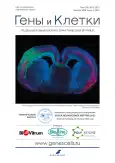Возбуждающие нейрональные проекции из инфрагранулярного в гранулярный слой в неонатальной соматосенсорной коре грызунов
- Авторы: Иджилова О.С.1, Симонова Н.А.1, Минлебаев М.Г.2,3, Малышев А.Ю.1
-
Учреждения:
- Институт высшей нервной деятельности и нейрофизиологии РАН
- Mediterranean Institute of Neurobiology, Aix-Marseille University
- Казанский (Приволжский) федеральный университет
- Выпуск: Том 18, № 4 (2023)
- Страницы: 771-773
- Раздел: Материалы конференции
- URL: https://journal-vniispk.ru/2313-1829/article/view/256342
- DOI: https://doi.org/10.17816/gc623337
- ID: 256342
Цитировать
Аннотация
Несмотря на то, что принципы развития центральной нервной системы предопределены генетически, нейронная активность коры при этом также критически необходима. Хотя этот вопрос является достаточно важным, на данный момент наше понимание той роли, которую нейронная активность играет в формировании функционально связанных ансамблей в развивающейся коре, довольно ограничено. Недавно было показано, что в соматосенсорной баррельной коре во время критического периода ее развития существуют транзиентные тормозные нейронные проекции. Наличие связей между нейронами инфрагранулярного и других слоев именно в период формирования баррелей говорит о критически важной роли этих связей в формировании зрелой колонковой организации баррельной коры. Несмотря на то, что найдены тормозные связи, остается вопрос, исчерпывается ли этим транзиентная коннективность в критический период развития баррельной коры, или же на этом этапе присутствуют оба типа (как тормозные, так и возбуждающие связи).
В данной работе мы попытались ответить на этот вопрос с помощью метода оптогенетической стимуляции нейронов инфрагранулярных слоев соматосенсорной баррельной коры неонатальных мышей in vitro. Вирусный вектор серотипа AAV.PHP.eB, содержащий последовательность канального родопсина-2, а также флуоресцентной метки Venus под человеческим синапсиновым промотором hSyn, вводился в мозг мыши методом церебрально-желудочковой инъекции на нулевой постнатальный день. Такой протокол трансдукции обеспечивал экспрессию конструкции в нейронах коры преимущественно 2/3, 5 и 6 слоев на седьмой постнатальный день. На седьмой постнатальный день были приготовлены переживающие корональные срезы мозга, содержащие баррельную кору. В рамках одной кортикальной колонки производилась оптогенетическая картирующая стимуляция инфрагранулярных слоев при одновременной электрофизиологической регистрации пирамидных нейронов в гранулярном слое. Нейроны регистрировались методом пэтч-кламп в конфигурации «целая клетка». Фиксируемый потенциал варьировался для того, чтобы различать между собой возбуждающие и тормозные постсинаптические токи.
Результаты наших предварительных экспериментов в неонатальной соматосенсорной коре свидетельствуют о наличии нейрональных проекций из инфрагранулярных слоев в гранулярный слой, что согласуется с уже известными данными. Однако в четвертом слое коры нами были зарегистрированы не только тормозные, но и возбуждающие постсинаптические токи, вызванные стимуляцией инфрагранулярных слоев, что позволяет сделать предположение о наличии возбуждающих связей между инфрагранулярными и гранулярным слоями на ранних этапах постнатального развития. Хотя необходимо проведение дальнейших экспериментов с регистрацией, наши результаты дают основания говорить о существовании еще более сложных, чем предполагалось ранее, сетевых взаимодействий, которые формируют облик четвертого слоя баррельной коры на ранних постнатальных стадиях развития.
Полный текст
Несмотря на то, что принципы развития центральной нервной системы предопределены генетически, нейронная активность коры при этом также критически необходима. Хотя этот вопрос является достаточно важным, на данный момент наше понимание той роли, которую нейронная активность играет в формировании функционально связанных ансамблей в развивающейся коре, довольно ограничено. Недавно было показано, что в соматосенсорной баррельной коре во время критического периода её развития существуют транзиентные тормозные нейронные проекции. Наличие связей между нейронами инфрагранулярного и других слоёв именно в период формирования баррелей говорит о критически важной роли этих связей в формировании зрелой колонковой организации баррельной коры. Несмотря на то, что найдены тормозные связи, остаётся вопрос, исчерпывается ли этим транзиентная коннективность в критический период развития баррельной коры или же на этом этапе присутствуют оба типа (как тормозные, так и возбуждающие связи).
В данной работе мы попытались ответить на этот вопрос с помощью метода оптогенетической стимуляции нейронов инфрагранулярных слоёв соматосенсорной баррельной коры неонатальных мышей in vitro. Вирусный вектор серотипа AAV.PHP.eB, содержащий последовательность канального родопсина-2, а также флуоресцентной метки Venus под человеческим синапсиновым промотором hSyn, вводили в мозг мыши методом церебрально-желудочковой инъекции на нулевой постнатальный день. Такой протокол трансдукции обеспечивал экспрессию конструкции в нейронах коры преимущественно 2/3, 5 и 6 слоёв на седьмой постнатальный день. На седьмой постнатальный день были приготовлены переживающие корональные срезы мозга, содержащие баррельную кору. В рамках одной кортикальной колонки производили оптогенетическую картирующую стимуляцию инфрагранулярных слоёв при одновременной электрофизиологической регистрации пирамидных нейронов в гранулярном слое. Нейроны регистрировали методом «пэтч-кламп» в конфигурации «целая клетка». Фиксируемый потенциал варьировался для того, чтобы различать между собой возбуждающие и тормозные постсинаптические токи.
Результаты наших предварительных экспериментов в неонатальной соматосенсорной коре свидетельствуют о наличии нейрональных проекций из инфрагранулярных слоёв в гранулярный слой, что согласуется с уже известными данными. Однако в четвёртом слое коры нами были зарегистрированы не только тормозные, но и возбуждающие постсинаптические токи, вызванные стимуляцией инфрагранулярных слоёв, что позволяет сделать предположение о наличии возбуждающих связей между инфрагранулярными и гранулярным слоями на ранних этапах постнатального развития. Хотя необходимо проведение дальнейших экспериментов с регистрацией, наши результаты дают основания говорить о существовании ещё более сложных, чем предполагалось ранее, сетевых взаимодействий, которые формируют облик четвёртого слоя баррельной коры на ранних постнатальных стадиях развития.
ДОПОЛНИТЕЛЬНАЯ ИНФОРМАЦИЯ
Вклад авторов. Все авторы подтверждают соответствие своего авторства международным критериям ICMJE (все авторы внесли существенный вклад в разработку концепции, проведение исследования и подготовку статьи, прочли и одобрили финальную версию перед публикацией).
Источник финансирования. Авторы заявляют об отсутствии внешнего финансирования при проведении исследования.
Конфликт интересов. Авторы декларируют отсутствие явных и потенциальных конфликтов интересов, связанных с публикацией настоящей статьи.
Об авторах
О. С. Иджилова
Институт высшей нервной деятельности и нейрофизиологии РАН
Автор, ответственный за переписку.
Email: olgaidzh@gmail.com
Россия, Москва
Н. А. Симонова
Институт высшей нервной деятельности и нейрофизиологии РАН
Email: olgaidzh@gmail.com
Россия, Москва
М. Г. Минлебаев
Mediterranean Institute of Neurobiology, Aix-Marseille University; Казанский (Приволжский) федеральный университет
Email: olgaidzh@gmail.com
Франция, Марсель; Казань, Российская Федерация
А. Ю. Малышев
Институт высшей нервной деятельности и нейрофизиологии РАН
Email: olgaidzh@gmail.com
Россия, Москва
Список литературы
Дополнительные файлы









